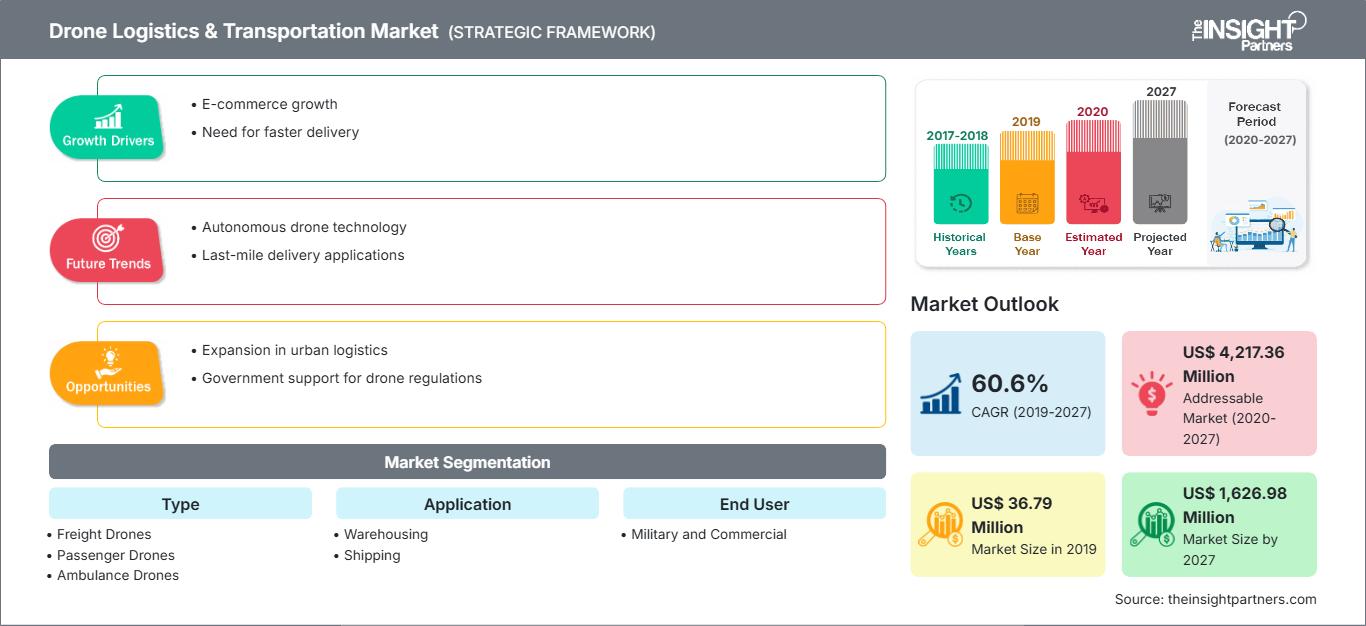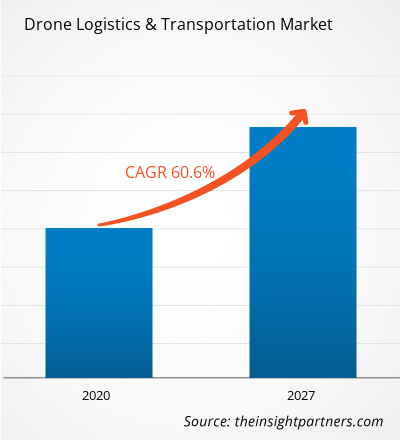2019 年无人机物流和运输市场价值 3679 万美元,预计到 2027 年将达到 16.2698 亿美元。预计在 2020 年至 2027 年的预测期内,无人机物流和运输市场的复合年增长率将达到 60.6%。
在最近的无人机行业,全球有几家公司正在向不同行业提供第三方服务,以满足他们的配送需求。第三方无人机物流和运输提供商的数量逐年快速增长,这归因于最终用户产生的巨大需求,这有助于无人机物流和运输市场多年来的发展。无人机物流和运输市场分散,因为该行业被不同地区的许多中小型企业占据。市场参与者不断投入大量资金,为客户提供先进和最优质的无人机物流和运输。无人机物流和在当前形势下,运输市场正在蓬勃发展,因为一些国家的政府正在简化无人机物流和运输的法律法规,这促进了无人机运营公司的数量增长。最近,美国联邦航空管理局(FAA)简化了通过无人机系统运送货物的规则,这增加了来自不同公司的申请数量。由于严格的立法,空运公司被限制使用该服务。在当前形势下,全球无人机市场的配送领域仍处于利基市场,因为很少有公司提供这项服务。Zipline 是美国著名的无人机配送服务提供商之一,在非洲运送药品、血液和疫苗。瑞士物流公司 Matternet 致力于通过无人机运送医疗用品,而该城市是无人机密集的城市。该公司凭借其技术和在运营城市的良好业绩,已获得美国联邦航空管理局(FAA)的认可,可以在美国测试配送服务。
电子商务领域的蓬勃发展以及无人机因其提供的各种优势而日益普及等因素,正在显著推动全球无人机物流和运输市场的发展。然而,缺乏熟练的运营商和运营困难阻碍了市场的增长。农村配送的普及为市场的增长提供了机遇。例如,2017年,坦桑尼亚政府宣布与Zipline合作,旨在为该地区提供紧急的按需药品、疫苗和血液服务。
自定义此报告以满足您的要求
您将免费获得任何报告的定制,包括本报告的部分内容,或国家级分析、Excel 数据包,以及为初创企业和大学提供超值优惠和折扣
无人机物流与运输市场: 战略洞察

- 获取本报告的主要市场趋势。这个免费样本将包括数据分析,从市场趋势到估计和预测。
您将免费获得任何报告的定制,包括本报告的部分内容,或国家级分析、Excel 数据包,以及为初创企业和大学提供超值优惠和折扣
无人机物流与运输市场: 战略洞察

- 获取本报告的主要市场趋势。这个免费样本将包括数据分析,从市场趋势到估计和预测。
无人机物流和运输市场洞察
多种优势使其接受度不断提升
无人机配送的优势吸引了包裹递送行业和电子商务行业的参与者,包括减少道路拥堵、提高安全性、优化路线灵活性、减少温室气体排放以及隔夜或当日送达。由于无人机配送服务大幅降低了最终用户的物流成本,预计未来几年无人机配送市场将持续增长。随着法规的进一步修改,以及越来越多的物流合作伙伴和电子商务参与者选择无人机服务,预计第三方服务提供商的数量也将增加,从而在未来几年加剧市场增长。早些年,一些政府法规限制了无人机在商业配送中的使用,然而,这些法规的修订正在帮助电子商务行业参与者以及一些包裹递送公司使用这项服务。
基于类型的市场洞察
无人机有着广泛的应用,可以方便快捷地运输包裹。它们被广泛用于运输小件物品、医疗产品,也可以运载乘客。这些无人机根据其用途有其自身的飞行限制。无人机既不允许低空飞行,因为它会撞到中高层建筑,也不允许高空飞行,因为它会撞到任何飞机。航空业规定了它们的飞行限制。在无人机类型的第一类分类中,它被细分为货运无人机、客运无人机和救护无人机。货运无人机进一步细分为货运无人机和配送无人机。
基于应用的市场洞察
配送无人机用于物流和运输行业,使整个包裹配送过程变得轻松便捷。在当前情况下,无人驾驶飞行器(称为无人机)在非军事用途中越来越受欢迎。现在,各组织,尤其是物流组织,正在检查无人机用于配送目的的有效性。按应用划分的无人机物流和运输市场由航运领域主导,该领域占有最高的市场份额。
无人机物流和运输市场的参与者专注于市场计划、收购和产品发布等战略,以保持其在无人机物流和运输市场中的地位。无人机物流和运输市场主要参与者的一些进展如下:
2019年1月,Drone Delivery Canada 开始测试 flacon,这是一款新型货物运输无人机,设计续航里程为 60 公里,可承载 50 磅货物。
2019年1月,Flytrex 最近在 B 轮融资中筹集了 750 万美元。该公司获得了 Benhamou Global Ventures (BGV) 的资金以及 BTOV 的额外投资。借助筹集到的资金,Flytrex 将扩大其在冰岛和北达科他州无人机运输方面的技术和运营规模。
无人机物流与运输市场区域洞察
The Insight Partners 的分析师已详尽阐述了预测期内影响无人机物流与运输市场的区域趋势和因素。本节还探讨了北美、欧洲、亚太地区、中东和非洲以及南美和中美洲的无人机物流与运输市场细分和地域分布。
无人机物流与运输市场报告范围
| 报告属性 | 细节 |
|---|---|
| 市场规模 2019 | US$ 36.79 Million |
| 市场规模 2027 | US$ 1,626.98 Million |
| 全球复合年增长率 (2019 - 2027) | 60.6% |
| 历史数据 | 2017-2018 |
| 预测期 | 2020-2027 |
| 涵盖的领域 |
By 类型
|
| 覆盖地区和国家 | 北美
|
| 市场领导者和主要公司简介 |
|
无人机物流与运输市场参与者密度:了解其对商业动态的影响
无人机物流与运输市场正在快速增长,这得益于终端用户需求的不断增长,而这些需求的驱动因素包括消费者偏好的演变、技术进步以及对产品优势的认知度的提升。随着需求的增长,企业正在扩展其产品线,不断创新以满足消费者需求,并抓住新兴趋势,从而进一步推动市场增长。

- 获取 无人机物流与运输市场 主要参与者概述
无人机物流和运输市场 — 按类型
- 货运无人机
- 货运无人机
- 送货无人机
- 客运无人机
- 救护无人机
无人机物流和运输市场 — 按应用
- 军事
- 商业
无人机物流和运输市场 — 按行业垂直领域
- BFSI
- 医疗保健
- 政府
- 零售
- 制造
- 其他
无人机物流和运输市场 —按地理
北美洲
- 美国
- 加拿大
- 墨西哥
欧洲
- 法国
- 德国
- 意大利
- 英国
- 西班牙
- 其他地区欧洲
亚太地区(APAC)
- 中国
- 印度
- 日本
- 澳大利亚
- 亚太地区其他地区
MEA
- 沙特阿拉伯
- 阿联酋
- 南部非洲
- 中东和非洲其他地区
SAM
- 巴西
- 其他地区SAM
无人机物流和运输市场 –公司简介
- Cheetah Logistic Technology (MercuryGate)
- 加拿大无人机交付
- Flirtey
- Flytrex Inc.
- Hardis Group
- Infinium Robotics
- PINC Solutions
- Volocopter GmBH
- 主力
- 滑索
- 历史分析(2 年)、基准年、预测(7 年)及复合年增长率
- PEST和SWOT分析
- 市场规模、价值/数量 - 全球、区域、国家
- 行业和竞争格局
- Excel 数据集
近期报告
相关报告
客户评价
购买理由
- 明智的决策
- 了解市场动态
- 竞争分析
- 客户洞察
- 市场预测
- 风险规避
- 战略规划
- 投资论证
- 识别新兴市场
- 优化营销策略
- 提升运营效率
- 顺应监管趋势






















 获取免费样品 - 无人机物流与运输市场
获取免费样品 - 无人机物流与运输市场